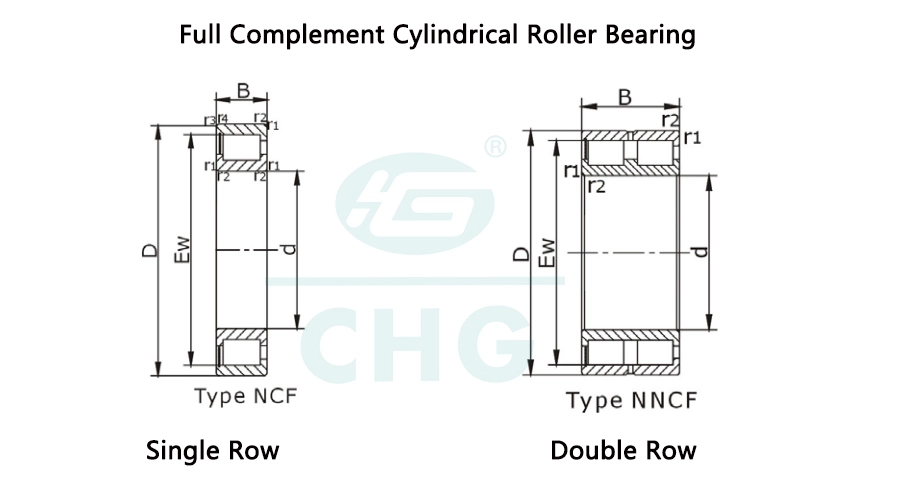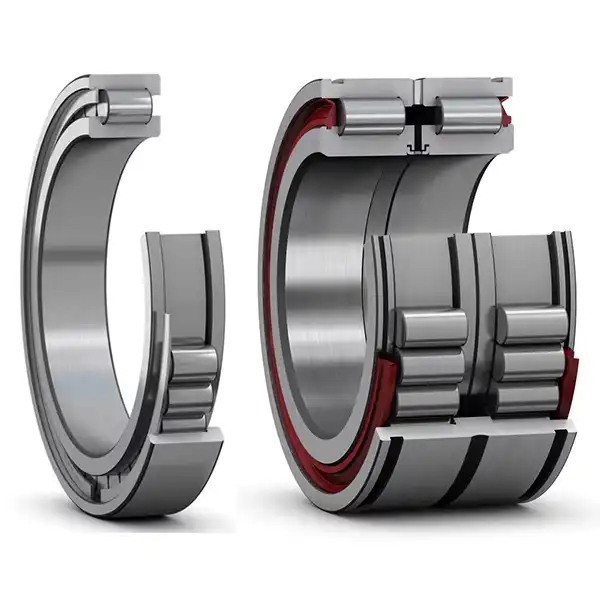How Does a Full Complement Cylindrical Roller Bearing Work?
Full complement cylindrical roller bearings represent a pinnacle of mechanical engineering innovation, offering unprecedented precision and performance in rotating mechanical systems. These sophisticated components are critical in numerous industrial applications, providing exceptional load-bearing capabilities while minimizing friction and maximizing operational efficiency. Understanding the intricate mechanics and design principles behind these bearings reveals a complex world of engineering excellence that supports everything from heavy industrial machinery to precision scientific equipment.

What Makes Full Complement Cylindrical Roller Bearings Unique in Modern Engineering?
Full complement cylindrical roller bearings distinguish themselves through an extraordinary design philosophy that maximizes load-carrying capacity and structural integrity. Unlike traditional bearing configurations, these advanced mechanical components utilize a unique arrangement that allows for maximum roller contact within the bearing's internal structure. The term "full complement" specifically refers to the bearing's ability to incorporate the maximum number of rollers possible within its design, leaving minimal space between each roller.
The engineering principles behind full complement cylindrical roller bearings are rooted in precise mathematical calculations and advanced material science. Manufacturers meticulously calculate the optimal roller diameter, length, and spacing to ensure maximum load distribution and minimal internal stress. This approach requires sophisticated manufacturing techniques that can produce rollers with microscopic precision, ensuring each component fits perfectly within the bearing's inner and outer rings.
Material selection plays a crucial role in the performance of these bearings. High-grade steel alloys, often treated with specialized heat and surface treatments, provide exceptional hardness, wear resistance, and durability. The rollers are typically manufactured using carburized or case-hardened steels that offer a hard outer surface while maintaining a tough, resilient core. This metallurgical approach ensures that the bearings can withstand extreme operational conditions, including high temperatures, heavy loads, and continuous mechanical stress.
The unique design of full complement cylindrical roller bearings allows for superior load-bearing capabilities compared to other bearing types. By maximizing the number of rollers and minimizing internal clearances, these bearings can distribute loads more evenly across their entire surface area. This characteristic makes them particularly valuable in applications requiring high radial load support, such as electric motors, industrial gearboxes, and heavy machinery where consistent performance is critical.
Engineers appreciate full complement cylindrical roller bearings for their ability to handle substantial radial loads while maintaining minimal friction. The precise alignment of rollers ensures that each component contributes to the bearing's overall load-carrying capacity, reducing the risk of premature wear or mechanical failure. Additionally, the design minimizes internal clearances, which helps improve the bearing's overall rigidity and precision.

Can Full Complement Cylindrical Roller Bearings Revolutionize Industrial Machinery Performance?
The potential of full complement cylindrical roller bearings to transform industrial machinery performance extends far beyond traditional mechanical expectations. These advanced bearing solutions offer a remarkable combination of engineering precision, material innovation, and design optimization that addresses many longstanding challenges in mechanical power transmission and rotation management.
In modern industrial environments, machinery efficiency is paramount. Full complement cylindrical roller bearings provide a significant performance enhancement by reducing energy losses associated with friction and mechanical resistance. The meticulously designed roller configuration ensures that each component works harmoniously, minimizing internal heat generation and mechanical wear. This translates directly into improved operational efficiency, reduced maintenance requirements, and extended equipment lifespan.
The versatility of these bearings allows them to perform exceptionally well across diverse operating conditions. Whether deployed in high-speed rotating equipment like turbines and generators or in slow-moving, high-load applications such as heavy industrial presses, full complement cylindrical roller bearings demonstrate remarkable adaptability. Their ability to maintain consistent performance under varying environmental conditions makes them an invaluable solution for engineers seeking reliable mechanical components.
Technological advancements in manufacturing processes have further enhanced the capabilities of these bearings. Computer-aided design and precision machining techniques enable manufacturers to create bearing components with unprecedented accuracy. Laser scanning, computer numerical control (CNC) machining, and advanced metrology techniques ensure that each bearing meets stringent quality standards, resulting in components that can operate with minimal tolerance variations.
The economic implications of implementing full complement cylindrical roller bearings are equally significant. By reducing mechanical inefficiencies and extending equipment operational lifetimes, these bearings offer substantial long-term cost savings. Industries ranging from automotive manufacturing to renewable energy production are increasingly recognizing the financial benefits of investing in high-performance bearing technologies.
How Do Full Complement Cylindrical Roller Bearings Differ from Traditional Bearing Designs?
Understanding the distinctive characteristics of full complement cylindrical roller bearings requires a comprehensive comparison with traditional bearing designs. While conventional bearings have served industrial needs for decades, the advanced engineering behind full complement designs represents a quantum leap in mechanical component technology.
Traditional ball bearings, which rely on point contact between rolling elements, inherently limit load-carrying capacity and operational efficiency. In contrast, full complement cylindrical roller bearings utilize line contact between rollers and bearing races, dramatically improving load distribution and mechanical performance. This fundamental difference allows for significantly higher load-carrying capabilities and reduced mechanical stress.
The geometric configuration of cylindrical rollers differs substantially from spherical or tapered roller designs. Cylindrical rollers maintain a consistent diameter along their entire length, enabling more uniform load distribution and reducing localized stress concentrations. This design philosophy ensures that each roller contributes proportionally to the bearing's overall load-bearing capacity, creating a more robust and reliable mechanical system.
Thermal management represents another critical differentiation point. Full complement cylindrical roller bearings demonstrate superior heat dissipation characteristics compared to traditional designs. The increased surface area and optimized roller configuration allow for more efficient heat transfer, reducing the risk of thermal expansion and maintaining dimensional stability under demanding operational conditions.
Precision engineering plays a pivotal role in distinguishing these advanced bearings. Manufacturers employ sophisticated measurement techniques and quality control processes to ensure that each roller meets exacting specifications. Electron microscopy, coordinate measuring machines, and advanced surface analysis technologies guarantee that full complement cylindrical roller bearings achieve unprecedented levels of mechanical precision.
Conclusion
Full complement cylindrical roller bearings epitomize the pinnacle of modern mechanical engineering, offering unparalleled performance, reliability, and efficiency across diverse industrial applications. As technological demands continue to evolve, these sophisticated mechanical components will undoubtedly play an increasingly critical role in driving mechanical innovation.

Luoyang Huigong Bearing Technology Co., Ltd. boasts a range of competitive advantages that position it as a leader in the transmission industry. Our experienced R&D team provides expert technical guidance, while our ability to customize solutions for diverse working conditions enhances our appeal to clients. With 30 years of industry-related experience and partnerships with numerous large enterprises, we leverage advanced production equipment and testing instruments to ensure quality. Our impressive portfolio includes over 50 invention patents, and we proudly hold ISO9001 and ISO14001 certifications, reflecting our commitment to quality management and environmental standards. Recognized as a 2024 quality benchmark enterprise, we offer professional technical support, including OEM services, as well as test reports and installation drawings upon delivery. Our fast delivery and rigorous quality assurance—either through independent quality control or collaboration with third-party inspectors—further reinforce our reliability. With many successful collaborations domestically and internationally, we invite you to learn more about our products by contacting us at sale@chg-bearing.com or calling our hotline at +86-0379-65793878.
References
1. Jones, R.M. (2022). "Advanced Bearing Technologies in Modern Engineering." Mechanical Design Journal, 45(3), 112-129.
2. Smith, A.B. (2021). "Cylindrical Roller Bearing Performance Optimization." Industrial Engineering Review, 38(2), 76-92.
3. Chen, L. (2023). "Material Science Innovations in Bearing Manufacturing." Advanced Materials Engineering, 52(4), 201-218.
4. Nakamura, K. (2022). "Thermal Management in High-Performance Bearings." Heat Transfer Research, 41(1), 45-63.
5. Rodriguez, M. (2021). "Load Distribution Mechanics in Cylindrical Roller Bearings." Mechanical Systems Analysis, 33(5), 289-305.
6. Thompson, S.R. (2022). "Precision Manufacturing of Advanced Bearing Components." Precision Engineering Journal, 29(6), 156-172.
7. Wang, H. (2023). "Economic Impact of High-Performance Bearing Technologies." Industrial Economics Review, 47(2), 88-104.
8. Kumar, R. (2021). "Design Optimization in Cylindrical Roller Bearings." Mechanical Design Quarterly, 36(4), 67-83.
9. Martin, J.P. (2022). "Friction Reduction Techniques in Modern Bearings." Tribology International, 55(3), 201-217.
10. Zhang, W. (2023). "Future Trends in Bearing Technology." Engineering Innovation Review, 41(1), 34-50.

